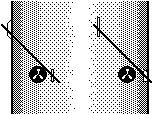10. INSTALL THE MAGNETIC TORQUERS.
View the whole assembled model
HST does not use rocket thrusters for controlling its attitude, as many other spacecraft do. The thruster exhaust would eventually condense on the optics and contaminate the instruments, deteriorating performance. Instead, when torque is needed (for desaturating, or changing speeds of the internal reaction wheels), an electric current is switched into the appropriate set of Magnetic Torquers -- long electromagnets -- which interact with the Earth's own magnetic field, applying the desired torque to the HST spacecraft (For more information, see the HST Fact Sheet and select the large illustration).

- From sheet B release one of the four MAGNETIC TORQUERS. Fold it in half along the hinge down the middle; start by creasing it over the edge of a metal ruler. Apply glue to hold each pair of pads together at the ends.
- Hold the black rail part of the torquer, and twist the pad at one end about 45 degrees to the rail. Twist the pad at the other end so it parallels the first one. It should be able to stand on a flat surface now. Orient them as shown (viewed from above).
- Prepare the three remaining torquers in the same way.
-
Hold the TELESCOPE TUBE with the word NASA right-side up in front of you. Locate the two black circles near the base of the tube, one to the right, and one to the left of the centerline defined by the keel fitting.

- Wet the bottoms of a MAGNETIC TORQUER's pads in glue. Place the short rectangular pad about 1/4 inch to the right of the right-hand black circle on the tube. Align the pad straight fore and aft. The rail of the MAGNETIC TORQUER extends forward at 45 degrees. Set the other pad onto the tube to hold the torquer in place. Apply more glue if necessary, and let dry.
- Repeat with another MAGNETIC TORQUER, placing its aft pad about 1/4 inch to the right of the left-hand black circle.
- Repeat with the two remaining MAGNETIC TORQUERs, continuing them around on the opposite side of the telescope tube. The four torquers should be equally spaced around the tube.



